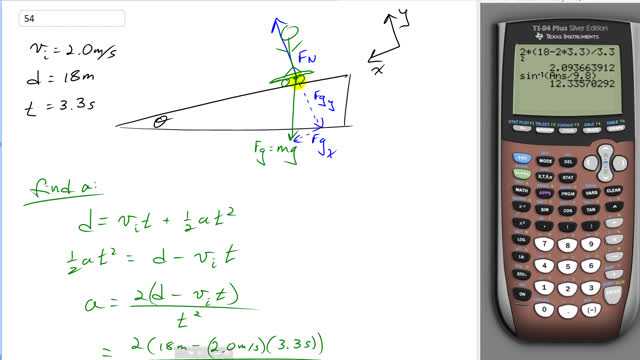
A skateboarder, with an initial speed of 2.0 m/s, rolls virtually friction free down a straight incline of length 18 m in 3.3 s. At what angle is the incline oriented above the horizontal?

In order to watch this solution you need to have a subscription.
This is Giancoli Answers with Mr. Dychko. The skateboarder is accelerating down the ramp, we're told that there is no friction. And so, a free body diagram has only gravity straight down and the normal force perpendicular to the surface of the ramp. We'll take x to be positive down the ramp. And we have gravity divided into its components here, where this angle in the triangle there is theta. So, we have Fgx is along the ramp and that's the opposite leg and we'll be using sine theta times mg to get that. But I'm getting ahead of myself there. First we have to figure out what the acceleration of the skateboarder will be, and then knowing its acceleration then we'll say that Fgx equals mass times acceleration because Fgx is the net force. And then we'll figure out what theta is knowing that Fgx is Fg sine theta. OK. First up is to find acceleration. So, we know the initial speed is 2 meters per second, the+ distance the skateboarder travels is 18 meters in 3.3 seconds. And we can use this formula to figure out acceleration. And we'll subtract V initial times T from both sides. And we get there one half acceleration times time squared equals displacement minus initial velocity times time. And then multiply both sides by 2 over T squared. And we isolate acceleration. And it equals 2 times displacement minus Vi t all over T squared. So, we have 2 times 18 meters minus 2 meters per second times 3.3 seconds, all divided by 3.3 seconds squared. And that gives 2.09366 meters per second squared. Then we talk about the force, and within the force is the is theta, so, that's how we can solve for theta here. So, we have Fgx is the only force horizontally speaking, and I mean horizontally in terms of along the x axis here. And so, that makes it the net force and the net force is always ma. And this x component is force of gravity times sine theta because this is the opposite leg of that gravity force triangle. And force of gravity is mg. And the m's cancel on both sides. And you can also divide both sides by g. And you get sine theta is acceleration over acceleration due to gravity. And that makes theta equal to the inverse sine of a over g. So, it's the inverse sine of 2.09366 meters per second squared divided by 9.8 meters per second squared which is 12 degrees must be the angle of incline for this ramp.